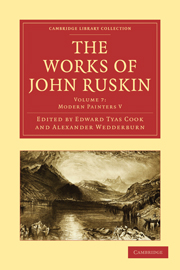Book contents
- Frontmatter
- Contents
- LIST OF ILLUSTRATIONS
- INTRODUCTION TO THIS VOLUME
- BIBLIOGRAPHICAL NOTE
- Modern Painters, Vol. V.
- PREFACE
- PART VI “OF LEAF BEAUTY”
- PART VII “OF CLOUD BEAUTY”
- CHAP. I THE CLOUD-BALANCINGS
- CHAP. II THE CLOUD-FLOCKS
- CHAP. III THE CLOUD-CHARIOTS
- CHAP. IV THE ANGEL OF THE SEA
- PART VIII “OF IDEAS OF RELATION:—FIRST, OF INVENTION FORMAL”
- PART IX “OF IDEAS OF RELATION:—SECOND, OF INVENTION SPIRITUAL”
- EPILOGUE (1888)
- APPENDIX
- Plate section
CHAP. IV - THE ANGEL OF THE SEA
Published online by Cambridge University Press: 07 September 2011
- Frontmatter
- Contents
- LIST OF ILLUSTRATIONS
- INTRODUCTION TO THIS VOLUME
- BIBLIOGRAPHICAL NOTE
- Modern Painters, Vol. V.
- PREFACE
- PART VI “OF LEAF BEAUTY”
- PART VII “OF CLOUD BEAUTY”
- CHAP. I THE CLOUD-BALANCINGS
- CHAP. II THE CLOUD-FLOCKS
- CHAP. III THE CLOUD-CHARIOTS
- CHAP. IV THE ANGEL OF THE SEA
- PART VIII “OF IDEAS OF RELATION:—FIRST, OF INVENTION FORMAL”
- PART IX “OF IDEAS OF RELATION:—SECOND, OF INVENTION SPIRITUAL”
- EPILOGUE (1888)
- APPENDIX
- Plate section
Summary
§ 1. Perhaps the best and truest piece of work done in the first volume of this book, was the account given in it of the rain-cloud; to which I have here little, descriptively, to add. But the question before us now is, not who has drawn the rain-cloud best, but if it were worth drawing at all. Our English artists naturally painted it often and rightly; but are their pictures the better for it? We have seen how mountains are beautiful; how trees are beautiful; how sunlighted clouds are beautiful; but can rain be beautiful?
I spoke roughly of the Italian painters in that chapter, because they could only draw distinct clouds, or violent storms, “massive concretions,” while our northern painters could represent every phase of mist and fall of shower.
But is this indeed so delightful? Is English wet weather, indeed, one of the things which we should desire to see Art give perpetuity to?
Yes, assuredly. I have given some reasons for this answer in the fifth chapter of last volume; one or two, yet unnoticed, belong to the present division of our subject.
§ 2. The climates or lands into which our globe is divided may, with respect to their fitness for Art, be perhaps conveniently ranged under five heads:—
1. Forest-lands, sustaining the great mass of the magnificent vegetation of the tropics, for the most part characterized by moist and unhealthy heat, and watered by enormous rivers, or periodical rains.
- Type
- Chapter
- Information
- The Works of John Ruskin , pp. 175 - 200Publisher: Cambridge University PressPrint publication year: 2010First published in: 1903



